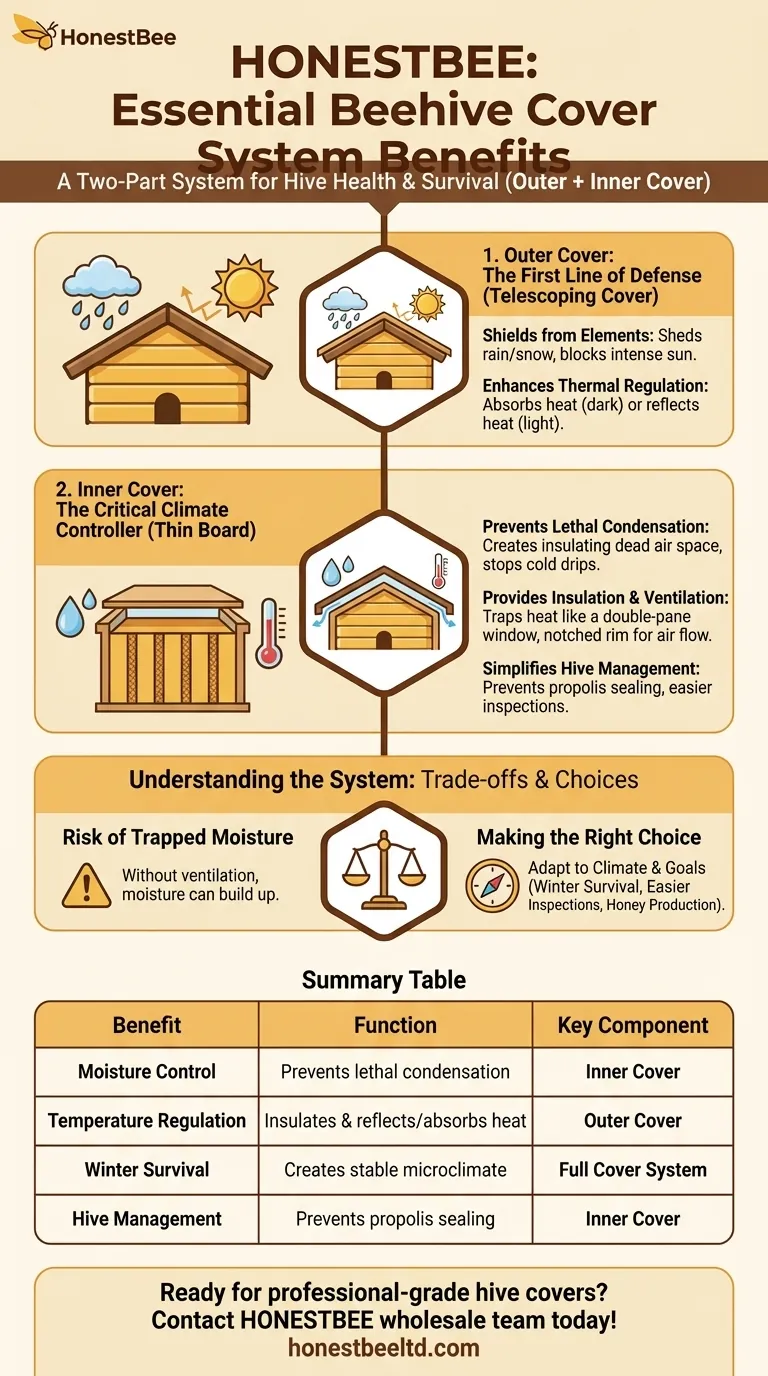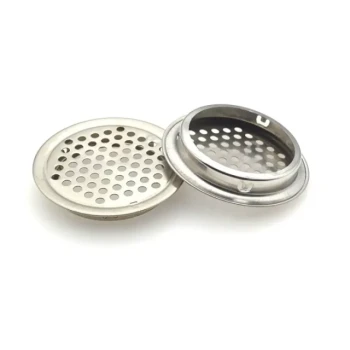In short, a beehive cover system is essential for hive health and survival. Its primary benefits are to control internal moisture, provide critical insulation against temperature extremes, and ultimately increase the colony's chances of surviving the winter. This protection leads to a stronger, more populous, and more productive colony in the spring.
The key insight is that a "beehive cover" is not a single component, but a system of two parts—the outer cover and the inner cover. They work together to create a controlled microclimate that shields the colony from weather and manages the two biggest threats to winter survival: moisture and cold.

The Outer Cover: The First Line of Defense
The outer cover, often called a telescoping cover, is the hive's roof. It is the most visible part of the system and provides the first and most direct layer of protection from the outside world.
Shielding from the Elements
The outer cover's most basic job is to keep the elements out. It sheds rain and snow, preventing water from entering the hive and chilling the bees.
In the summer, it also shields the colony from the direct, intense heat of the sun, helping to prevent the hive from overheating.
Enhancing Thermal Regulation
The outer cover serves as a thermal buffer. A dark-colored cover can absorb solar radiation on a cold but sunny day, helping to warm the hive.
Conversely, a light-colored cover will reflect solar heat, which is beneficial in hotter climates to help the bees maintain a stable internal temperature without expending excess energy.
The Inner Cover: The Critical Climate Controller
The inner cover is a thin board that sits directly on top of the uppermost hive box, just underneath the outer cover. While less obvious, its role in managing the hive's internal environment is arguably more critical.
Preventing Lethal Condensation
Bees release a significant amount of warm, moist air through respiration. When this warm air hits the cold surface of an outer cover in winter, it condenses into water droplets.
These cold drips can fall onto the cluster of bees, chilling and killing them. The inner cover creates a dead air space that insulates the warm hive air from the cold outer cover, dramatically reducing this deadly condensation.
Providing Insulation and Ventilation
The pocket of air trapped between the inner and outer covers provides a crucial layer of insulation, similar to how a double-pane window works. This helps the hive retain the heat generated by the bee cluster, reducing the amount of food they must consume to stay warm.
Many inner covers also feature a notched rim, which can be used to provide an upper entrance for ventilation or as an exit for bees, which is especially useful in winter when the main entrance may be blocked by snow.
Simplifying Hive Management
Without an inner cover, bees will "glue" the outer cover directly to the top hive box using propolis and wax. This can make removing the cover extremely difficult and disruptive to the colony.
The inner cover provides a clean separation, making hive inspections quicker, easier, and less stressful for both the beekeeper and the bees.
Understanding the Trade-offs
While essential, a cover system must be managed correctly. Simply placing a lid on the hive without understanding the principles can lead to problems.
The Risk of Trapped Moisture
If a cover system is completely sealed with no ventilation, it can trap moisture. An inner cover without a ventilation notch or a dedicated moisture-absorbing quilt can sometimes do more harm than good in a very humid winter climate.
Configuration Matters
There is no single "best" cover for all situations. A beekeeper in a cold, snowy climate will prioritize insulation and moisture control, while a beekeeper in a hot, arid region will focus on ventilation and reflecting solar heat.
Making the Right Choice for Your Goal
Your specific cover setup should be adapted to your climate and beekeeping objectives.
- If your primary focus is winter survival: Use a two-part system with an inner cover to create an insulating air gap and manage condensation.
- If your primary focus is simplifying hive inspections: The inner cover is non-negotiable, as it prevents the bees from gluing the outer cover shut.
- If your primary focus is maximizing honey production: Ensure excellent winter survival with a proper cover system, as a stronger post-winter colony will build up faster and gather more nectar.
Ultimately, a well-managed cover system gives you, the beekeeper, control over the hive's internal environment.
Summary Table:
| Benefit | Function | Key Component |
|---|---|---|
| Moisture Control | Prevents lethal condensation from dripping on bees | Inner Cover |
| Temperature Regulation | Insulates against cold and reflects/absorbs heat | Outer Cover |
| Winter Survival | Creates a stable microclimate, reducing colony stress | Full Cover System |
| Hive Management | Prevents propolis sealing, making inspections easier | Inner Cover |
Ready to equip your apiary with professional-grade hive covers? A proper cover system is fundamental to colony health and your beekeeping success. At HONESTBEE, we supply durable, well-designed beehive covers and complete beekeeping equipment to commercial apiaries and distributors through our wholesale-focused operations. Let us help you build stronger, more productive hives. Contact our wholesale team today to discuss your needs and request a quote!
Visual Guide

Related Products
- Professional Insulated Winter Hive Wrap for Beekeeping
- Inner Beehive Cover for Beekeeping Bee Hive Inner Cover
- Stainless Steel Round Beehive Air Vents for Ventilation
- Professional Drop-Style Hive Handles for Beekeeping
- Premium Comfort Grip Spring-Loaded Hive Handles
People Also Ask
- Why is it important to insulate beehives during winter? Boost Your Colony's Survival Rate
- Should bee hives be insulated? Protect Your Colony from Moisture, Not Just Cold
- What are the steps to properly wrap a beehive for winter? Ensure Your Colony Survives the Cold
- Is it always necessary to insulate beehives? A Guide to Winter Survival & Colony Health
- What factors ensure bees stay warm and healthy during winter? Master the 3 Keys to Hive Survival



















